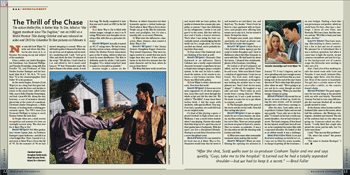Q & A: The Thrill of the Chase
 Not only did Scott Wiper ’92 write and direct this film, but he also stars in it, as Boomer, the young ex–cop and subject of the manhunt.
Not only did Scott Wiper ’92 write and direct this film, but he also stars in it, as Boomer, the young ex–cop and subject of the manhunt.
It has a stellar cast: Andre Braugher, Joe Pantoliano, Lou Diamond Phillips, and Natasha Henstridge, along with Ben Parrillo ’92, and Professor of Film Studies Jeanine Basinger and her husband John M.A.T. ’66, M.A. ’79. Larry Sher ’92 is the cinematographer; Brad Fuller ’87 is the producer.
As the movie begins, Boomer (Scott Wiper) is on a drug bust that goes bad. Jaded, he quits the force and decides to return to the small town called Cedar Falls, marry Kelly (Natasha Henstridge), and lead a peaceful life. Along the way, however, a case of mistaken identity places him at the center of a manhunt. Cleveland (Andre Braughuer), a Mafia hit–man, is tracking down a missing government agent. The FBI’s man (Lou Diamond Phillips) is trying to reach Boomer before the mob does.
Q: People often see a work receive recognition and assume it’s been an overnight success story. Was that true for A Better Way to Die?
Scott Wiper: No! After graduation I wrote Captain Jack—in Professor Basinger’s spare bedroom—and did it as a low–budget film. Then, I moved to L.A. and wrote A Better Way to Die in the fall of ’95. By the summer of ’96 we had started shopping it around. When we still hadn’t gotten it financed by that winter, we’d run out of options and we needed a marketing tool. I said, “Let’s go to Ohio and shoot the first 10 minutes of the script.” We did that, I took it back to L.A. and edited it, but it wasn’t until January ’99 that Newmarket made the deal to finance the whole movie. It took that long. We finally completed it later that year and it aired on HBO in the fall of 2000.
Q: A Better Way to Die is filled with violent images, enough to earn it an R rating. What were your thoughts on creating a film with this as a pervasive element?
Scott Wiper: Actually, it earned an NC–17 rating twice. We had to keep shaving certain scenes, editing it down, before the Motion Picture Association gave us the R rating, which is what you need for most distributors. The film is definitely made for adults. I told Andre Braugher, “It’s a violent script but I want to make it as beautiful as possible.”
Jeanine taught a course on the Western, in which characters test their humanity against a violent landscape. That’s what A Better Way to Die is about. People can go to the film for entertainment and gunfights, but it’s also a morality tale, as are many Westerns.
Q: What were the influences—characters, films, themes—that created A Better Way to Die?
Scott Wiper: I like Jimmy Stewart, Humphrey Bogart characters. They weren’t Superman. They were trying to survive in a world that was much larger than they were. If the audience learns in the first five minutes that the main character can’t be beat, where do you go from there?
The films that have really moved me and stayed with me have pathos, the quality or element that arouses pity, sympathy, or sorrow. I have that definition on my refrigerator; I wrote it out and gave it to the actors. Mix that with humor and it lends a bizarre element. That’s what I was trying for, here: sarcastically cynical, acknowledging that the world can be a rough place, but if you can find one friend, you’re probably doing better than most.
Q: How about Clint Eastwood: were you thinking of his work as well?
Scott Wiper: Obviously Clint Eastwood is an influence. Harry Callahan was a totally unprecedented character: he wasn’t a superhero; he was a simple man trying to grasp a complex system. In the end, he fails to understand the system, so he resorts to violence— a very human reaction. Dirty Harry was filled with pathos.
Q: Scott Wiper is writer, director and actor. How does that work?
Scott Wiper: It forces me to be more organized; it’s all about preparation. Larry Sher and I went through the whole script and did the shot list. We called it “The Bible”; it was about three inches thick. I did the same with wardrobe, with special effects. That way, if we had a question, we could fall back on our original notes.
It’s kind of like playing a sport—I played football in high school and at Wesleyan. I was a much better student when I was playing. Parents who make their kids drop out of a sport because of their grades have it backwards. With the sport, you live a disciplined lifestyle. Having to act and direct forced me to be a more disciplined artist.
Brad Fuller: No one wanted to let Scott star in A Better Way to Die. Financiers would hear that he wrote it and wanted to act and direct, too, and they’d say, “No, thanks.” Here’s Scott: he lives in a tiny apartment with no furniture— and people were offering him money not to star in it, but he turned it down. He kept his vision.
Q: Despite your youth, your relative anonymity, you found an all–star cast. How did you make this happen?
Scott Wiper: Mark Ross at CAA (Creative Artists Agency) got the script to Andre Braugher, and I went to Baltimore, where they film Homicide, to meet with him. We had lunch for about five hours. I showed him storyboards, photos of the locations, everything.
He looked at all we’d prepared, we talked, and he asked questions. Then he said to me, “After next March I have a window of opportunity. Count me on board. You look sane, well–organized…” and he hesitated, as though he was looking for another way to compliment me. “And I don’t do too many drugs?” I offered. He laughed at my joke and said, “That’s what an actor needs from a young director.” When he signed on, it was a peak moment. He made it easier for us to get others to commit, as well.
Q: The Basingers played the parts of the rector and the rector’s wife. How did that casting take place?
Scott Wiper: It was an opportunity for me to have Jeanine, my mentor, my film–mother, in my film and get her out to Ohio. There are certain people you know are great in front of a camera. She’s so earnest, so authentic. It was a fun day when we did the shooting with Jeanine and John.
Q: What were some other memorable moments when making this movie?
Scott Wiper: When we were filming the opening ten minutes in January ’97: It was 5 degrees, and we were spending only just enough money to get it right, so we’d have this as a marketing tool. At the end of the day I knew this was it! That’s what kept this project alive: when we said, “We’re going to go out and do it—even though we don’t have the financing.” When you start that energy, it keeps on going.
Brad Fuller: My second day on the set: we were all fired up, Scott’s doing his own stunts, and he jumped straight into a ditch from a moving car.
After the shot, Scott walks over to co–producer Graham Taylor and me and says quietly, “Guys, take me to the hospital.” It turned out he had a totally separated shoulder—but we had to keep it a secret. The bond company, if they heard he was injured, would have been all over us, so he completed the entire film with a separated shoulder. He looked at this as an athlete would: it was a challenge.
Ben Parrillo: While Scott and Brad were working out details in L.A., I was out in Ohio for seven months, in charge of getting all the locations— on zero budget. Finding a barn that was picturesque and perfect, which we could burn for free—that was a challenge. I drove all over Ohio, into Kentucky. We’d see a barn, find the owners, and say, “We’d like to burn your barn down—for free.”
Larry Sher: That barn burning: film–making is about control— but a fire is fast and out of control. We planned for it beforehand like it was a military operation, but when it came time to light the match, we put cameras everywhere and just let it go. In the background out of camera range the firetrucks were waiting to take care of it.
Also, I had a lot of fun working inside the motel room with Scott and Natasha. It was small, intimate filmmaking, right there, over his shoulder. Most of the movie is hand–held. You get into a certain sense of balance after a while, so the camera doesn’t shake.
Brad Fuller: The peak experience for me was being at the premiere with my wife and family. Twentieth Century Fox had to turn away 400 people; the road was blocked off, so many people wanted to come.
At the theater, when Jeanine and her husband John came on the screen, about half the audience—the Wesleyan contingent— shrieked and cheered. The rest of the audience had no clue what was going on. Someone asked me afterwards, “I really liked that couple who played the rector and his wife, but I’ve never seen them.”
I said, “That was my film professor.”
“Oh, what’s his name?” the person asked me.
“Her name is Jeanine Basinger,” I said.

